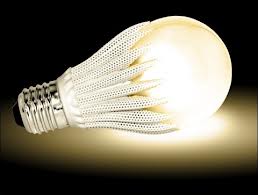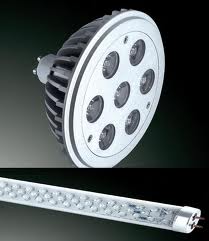Light Sources Part I – LED’s
- March 8, 2013
There is a lot of buzz these days in the lighting industry about LED, technically know as Solid State Lighting. Everybody is jumping onto the LED bandwagon. I get emails everyday from manufacturers from the Far East trying to sell me their LED products. Beware, there is a lot of bad LED product in the marketplace. Conversely there is a lot of good LED product available too. Hopefully this posting will enable you to distinguish between the two.
LED is an energy efficient light source that may or may not be dimmable. Check the product information to be sure. It is a product with a long life. Manufacturers claim up to about 27 years under normal operating conditions. The light output degrades slowly over the life of the LED meaning it does not burn out all of a sudden.
An LED is a Light Emitting Diode, a simple type of semiconductor that is similar to semiconductors used in computers. It is a solid material that conducts electrical current. Light is emitted from the semiconductor die which is a chip of semiconductor material treated to create a positive-negative junction. When voltage is applied the current flows from the positive to the negative side and excess energy is emitted as a photon and heat is emitted in the form of conduction. The natural color of the photon is not white. What we see today as LED lights require the LED to be coated with different materials to give white light (as well as many other colors). LED’s are a directional light source by nature. They emit light in one direction. In order for an LED bulb to emit light like an incandescent light bulb reflectors must be used inside the LED capsule. That’s the technical stuff.
 |
| Typical LED replacement light bulb. |
Looking at the picture to the left you will see a typical LED replacement light bulb. Notice the fins on the bottom of the bulb. They serve as the heat sink. This is probably the equivalent to a 40 watt incandescent light bulb. Inside are many individual LED chips arranged in an “array” to product sufficient light output to generate about 800 lumens. The reason you have not seen any 100 watt equivalent LED replacement bulbs is because they have not figured out how to dissipate the heat that would result in generating about 1,600 lumens. Imagine a heat sink twice the size of this one! You could not get the light bulb into the socket.
 |
| Examples of directional and under cabinet LED’s. |
Looking at the photo to the right you will see an example of an LED replacement directional light bulb, probably replacing a PAR30. The fins on the back are the heat sink. Below that is an example of an under cabinet linear LED fixture comprised of many LED chips. They are arrayed in a linear fashion to provide a even distribution of light on a counter top. This type of linear fixture can also be used as cove or toe kick lighting. In my opinion the best residential application today for LED lighting is this type of under cabinet lighting.
There are a few things you should be aware of when considering LED lighting for your home.
First is the cost. The payback period for LED vs incandescent is between 4 to 7 years. LED technology is doubling about every 18 months following Moore’s Law. This means a couple of things for you. First, prices are sure to come down in the next few years. Second, new and better LED products are going to be available in the next few years. Imagine LED technology being like computer technology in the 1980’s. So the question is: Do you wait or do you jump in now, knowing that the product you buy today will be far surpassed in the next few years? Keep in mind that these LED’s will supposedly last for up to 27 years under normal operating conditions and hours. Conversely if everybody had waited for computer technology to improve before jumping in, the technology might have stalled. The benefits of buying LED now, like energy conservation, might outweigh the uncertainty of what future LED technology will be.
The next thing you need to be aware of is quality. There are HUGE quality differences in today’s LED products. These differences could ruin your LED lighting experience if you do not do your homework. LED’s are manufactured by lots of different companies in lots of different factories all over the world. Like everything else some factories have better quality control than others. Individual LED chips have individual properties that distinguish them from each other. Good quality control means that LED’s with the same characteristics are grouped (binned) together. This means the LED’s with the same color qualities and same lumen output should be used to make a fixture or replacement bulb. These will perform as they are rated to perform. Also as with anything else a low price might be a red flag.
Color temperature and CRI (reference my previous posting) are two of the big considerations. If you get an LED with the wrong color temperature it can feel like you are living in a parking garage. If you get one with poor CRI you will be very disappointed about how items in your home look. Maybe the drapes on your windows will look green instead of orange. Remember CRI should be in the mid-80’s and color temperature should be around 3000K for relaxing light.
Lighting in your home is a big deal. My advice would be to try LED and see how you like it before going all in, and get the best you can afford.
Please visit my website, fogglighting.com, and email me with any questions. I do not have all the answers, but I know where to get them.
